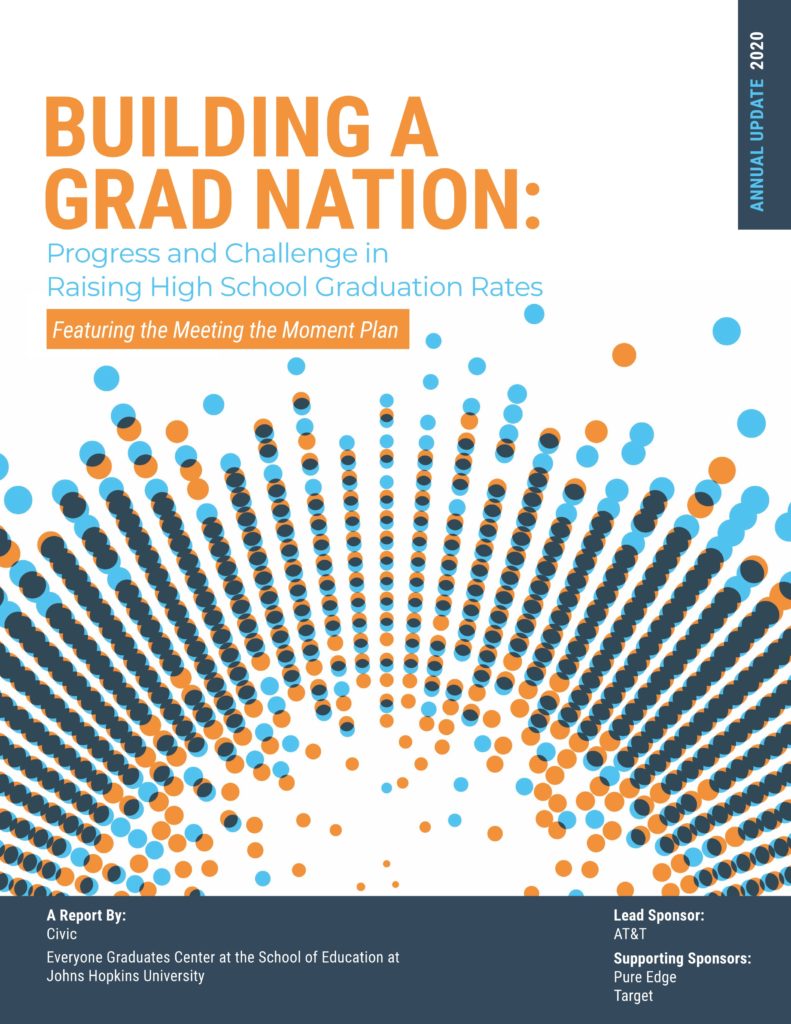
Authored by Civic and the Everyone Graduates Center at the Johns Hopkins University School of Education, and released annually in partnership with the Alliance for Excellent Education and America’s Promise Alliance, the Building a Grad Nation report examines both progress and challenges toward reaching the GradNation campaign goal of a national on-time graduation rate of 90 percent. AT&T, lead sponsor, has supported the report series since its inception through AT&T Aspire, the company’s commitment since 2008 to graduate more students from high school ready for college and career. Pure Edge Inc., dedicated to bringing learners and educations success through focus, and Target, are supporting sponsors.
Follow this link to access the 2020 Building a Grad Nation Report webpage.
INTRODUCTION
The nation has been committed to reaching a 90 percent graduation rate equitably for nearly 20 years. In 2010, the GradNation campaign launched a focused effort to reach that goal by the Class of 2020.
Steady progress has been made toward this goal. After 30 years of stagnating graduation rates, the country has seen 14 consecutive years of increasing graduation rates since 2004. In 2018, the nation once again reached an all-time high national graduation rate of 85.3 percent and 3.8 million more students have graduated rather than dropping out since the turn of the century. These additional graduates produce benefits to the nation’s economy, health, and civic society and position themselves to pursue the American dream.
Notably, gains have been driven by improvements among underserved students, with Black, Hispanic, low-income, and students with disabilities all out-pacing the national rate of increase. These improvements have persisted into postsecondary education, with Hispanic and Black students more than doubling their enrollment rates, and low-income students enrolling at rates that match their middle-income peers.
Across the nation, most students attend high schools with a graduation rate already at 90 percent or higher, but a disproportionate number of four-year non-graduates remain trapped in a subset of schools where the graduation rate is only 41.8 percent. Low- income, Black, Hispanic, English Learners, American Indian, and students experiencing homelessness and students with disabilities are all overrepresented in these schools, calling into question equal opportunity for students, regardless of race, socio-economic background, or any other challenge they may face.
Still, there is crucial work to be done.
Now, more than ever is the time to commit to meeting the moment on high school graduation and redoubling our efforts to prepare students for the rigors of postsecondary education, training, and work.
There is great uncertainty rippling through the world. As local and state economies are severely affected by the global pandemic, and predictions for a return to normalcy vary, much is unknown about what the future holds. What is clear is that the COVID-19 pandemic has reshaped education in this country for the Class of 2020 and beyond.
We must continue to analyze all available data to understand COVID-19’s full impact. As the nation reviews the response of the health system and identifies ways for the economy to recover, it must also conduct a national review of our education system in times of crisis. In this moment, we must also do everything possible to provide students across America with a quality education and the supports they need, educationally, mentally, and physically to be able to come out of this crisis prepared for future success.
Follow this link to access the 2020 Building A Grad Nation webpage.
Report Links:




